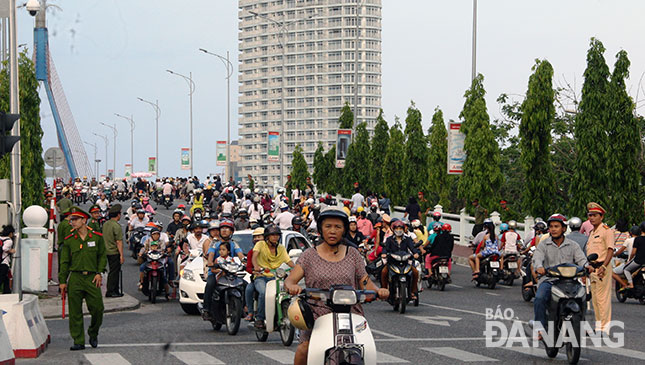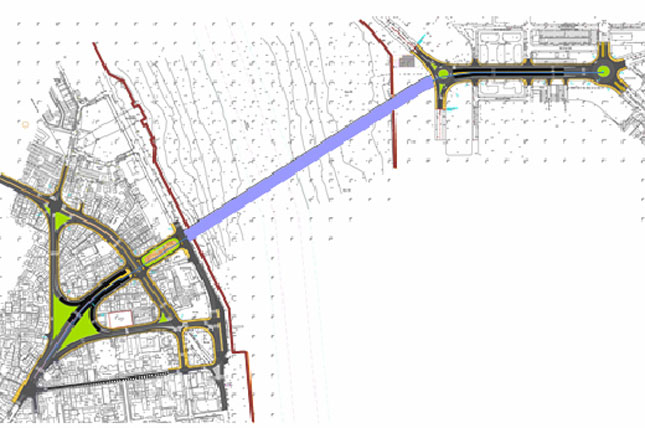Construction of Han River tunnel is a must for a modern, civilised city
Recently, there have been many differing public opinions about the plan to construct a new tunnel under Da Nang’s Han River, in terms of both its cost and its necessity. In a bid to give the public an objective insight into this project, the municipal Department of Transport recently gave further explanations about why the city leaders are strongly determined to construct the tunnel, as well as more details about their preparations for the project.
 |
| Traffic at the western end of the Han River Bridge |
With regard to the necessity of this large-scale project, Da Nang is seeing a rapid growth in urbanisation on the eastern side of the city, with a boom in residential areas and apartment buildings, and therefore there is a growing public demand for a new crossing over the Han River. In addition, there is an upward trend in tourist numbers to the Son Tra and Ngu Hanh Son districts, and there is a sharp rise in the number of local vehicles. Therefore, the construction of the new river crossing should help to avoid in the future the traffic congestion that other large Vietnamese cities are currently facing.
The construction of this underwater crossing totally matches with the Prime Minister-approved master urban plan towards 2030 with a vision to 2050, and the city’s top priority to develop transport infrastructure to boost the city’s growth.
It usually takes between 7 and 10 years in total to conduct research into a river crossing project, make the preparations, and carry out the construction work. If the preparatory work for this project progresses well, work is expected to start on the tunnel in 2018 at the earliest.
The proposal to build another river crossing was first unveiled late in 2015 by the city leaders. In October 2015, the city leaders asked the city’s Transport Department and other relevant agencies to conduct research into the building of a new river crossing between the Han River and the Thuan Phuoc bridges, but debated whether it should be a bridge or a tunnel.
At a meeting held by the municipal Party Committee (PC) in December 2015, the People’s Committee gave the green light to the building of a river crossing to link the intersection of Dong Da and 3 February streets in Hai Chau District with Son Tra District’s Van Don on the eastern bank.
In addition, a group of the city leaders paid a working visit to Ho Chi Minh City to learn more about the implementation of the Saigon River Tunnel project, which is Viet Nam’s first-ever submarine tunnel and arguably the largest of its kind in South East Asia.
 |
| An architect’s plan of the new tunnel |
In March 2016, a seminar took place in the city to collect opinions from local experts and scientists. All the comments were then submitted to the city leaders for consideration.
One month later, the municipal Transport Department was asked to carry out geological explorations, complete financial estimates, propose suitable investment models, and develop construction and maintenance plans for the river crossing.
After that, a design contest for the new river crossing was held in the city, and attracted a total of 6 joint-ventures from 11 prestigious design companies from both home and abroad. However, no entries were selected because of their failure to meet such criteria as traffic arrangements and special architecture.
In October 2016, the city leaders reached a final decision to build a tunnel under the river because a tunnel, as opposed to a bridge, would allow for an ‘airier river’ and ensure safer travel for local vehicle users, especially in stormy and rainy weather.
Finally, in December 2016, the go-ahead was given for the construction of a straight tunnel. In comparison with a curved tunnel, a straight one may be more costly due to the relocation of 210 households, but it is a perfect way to ensure that the new tunnel will link with the local public transport system, as well as promote urban development along the western bank of the river.
Currently, the city leaders are willing to continue receiving constructive comments from experts and the public about this large-scale project. Domestic and foreign experts will also be invited to assist relevant local agencies to conduct feasibility studies on the construction of the tunnel, and select suitable investment models, in a bid to guarantee the safety of traffic users once the tunnel is put into use and fully tap its functionality.
The above explanations clearly demonstrate that the city authorities have made a well-thought-out decision to deploy this project, after careful and thorough consideration.